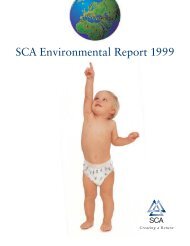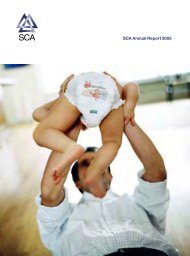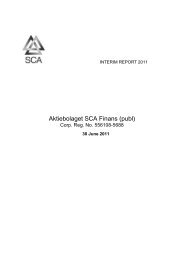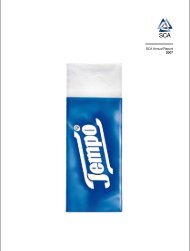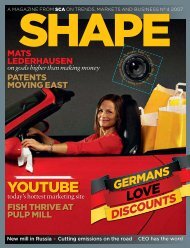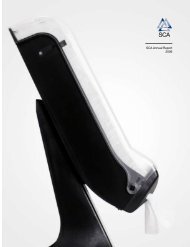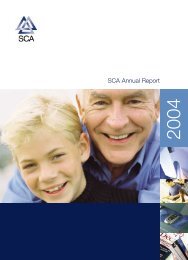Annual Report 1998
Annual Report 1998
Annual Report 1998
You also want an ePaper? Increase the reach of your titles
YUMPU automatically turns print PDFs into web optimized ePapers that Google loves.
6<br />
Business control and financial goals *<br />
The Group objective is to provide SCA’s shareholders with good growth in value and a high level of dividends.<br />
To meet this objective, SCA has developed calculation methods based on cash flows, by means of which the<br />
earnings capacity and long-term profitability of the business can be evaluated continuously.<br />
The objective is to give SCA’s shareholders a return on investment<br />
that is competitive within the forest products industry.<br />
Up to now, the return on market value of SCA’s shares has been<br />
set at between 13% and 15% per year over an economic cycle.<br />
This objective requires that the Company maintains a stable<br />
and increasing cash flow – high earning capacity – and that it<br />
be financially stable. The level for the capital return requirement<br />
varies, however, depending on the long-term trend of<br />
nominal risk-free interest rates and the Company’s risk profile.<br />
Nominal interest rates have dropped parallel with declining<br />
inflation. As a result, the stock market’s yield requirements<br />
have also been adjusted. To adapt more effectively to varying<br />
levels of nominal interest rates, the goal for a return on the<br />
market value of SCA’s shares is now expressed as the sum of<br />
the long-term risk-free interest rate (at year-end <strong>1998</strong> about<br />
4%) and a risk premium of 6%. The level of risk premium is<br />
adapted to the Company-specific risk, calculated in beta values<br />
(see SCA share data, page 9). If, over an extended period, SCA’s<br />
beta value deviates significantly from the market average (that<br />
is, if it deviates significantly from 1.0), the risk premium<br />
should be changed to a corresponding degree.<br />
During 1999, SCA will introduce an incentive program that<br />
reflects the Group’s ambition to provide a good return on SCA<br />
shares. The program will be fully activated only if the return on<br />
* See page 73 for definitions of key ratios.<br />
SCA’s shares exceeds the trend for comparable companies. (See<br />
Note 28).<br />
Business control<br />
SCA uses a method based on cash flow to control the Group’s<br />
business operations. In accordance with this method, Cash<br />
Value Added (CVA), each business unit is assigned an annual<br />
cash flow requirement based on the present value of strategic<br />
investments, the economic life and the return that each unit<br />
should generate. Comparable requirements are imposed on<br />
new strategic investments in acquisitions of companies and<br />
property, plant and equipment. Under this method, for example,<br />
a specific investment will not be made if it does not<br />
meet the requirements. To achieve value-added growth for the<br />
shareholders, SCA is channeling the expansion of its business<br />
toward areas that are believed to offer the greatest surplus,<br />
Cash Value Added.<br />
In practice this means that SCA is making increased resources<br />
available to the Hygiene Products and Packaging business<br />
areas to enable them to expand and make acquisitions.<br />
Growth in demand for these products in Europe and other<br />
parts of the world is expected to be favorable during the years<br />
ahead.<br />
Key ratios and financial goals<br />
Key ratios are reported excluding nonrecurring items through 1995.<br />
The cash flow measurement is reported from the date of the PWA acquisition (1995).<br />
Average<br />
Result result Goal/Req.<br />
1994 1995 1996 1997 <strong>1998</strong> 5 yrs <strong>1998</strong> 1999<br />
Cash flow<br />
Operating cash flow (SEK billion) 6.6 5.8 6.5 7.0 6.51 Cash flow from current operations<br />
6.4 7.0<br />
(SEK billion) 4.9 4.2 4.9 4.3 4.61 Rates of return<br />
3.2 3.8<br />
Capital employed (%) 10 15 11 12 14 12 132 122 Shareholders’ equity (%) 7 16 10 12 13 12 122 112 Financial measurements 3<br />
Debt/equity ratio (multiple) 0.6 0.8 0.8 0.9 0.8 0.8 0.7 0.7<br />
Market-adjusted debt/equity<br />
ratio (multiple) 0.5 0.8 0.7 0.6 0.7 0.7 – –<br />
Debt payment capacity (%) 32 31 30 33 32 32 35 35<br />
1 Average value pertains to 1995–98.<br />
2 Requirement adjusted to current interest and inflation levels.<br />
3 Net debt includes pension liabilities.




